The Apiarist in 2024
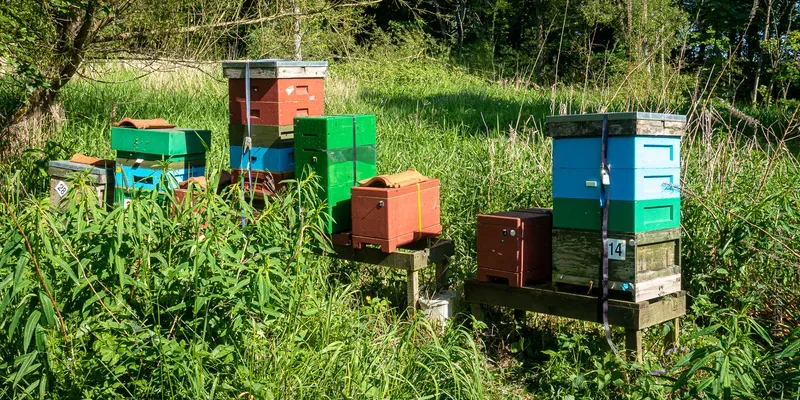
The annual review of the year on The Apiarist.
What's popular, what's not ... and what does this tell us about the beekeeping year?
Strangely, although I didn't write a review of the beekeeping season in December 2023, I did manage to summarise the "93% of my beekeeping year" that I spend writing the posts for this website. I've done this in (many) previous years as well, though not all are entitled 'The Apiarist in X'.
Perhaps these reviews are a bit self-indulgent?
After all, the majority of readers presumably come here for the discussion of bees and beekeeping, not my pontificating on what was popular and why, or what remained unread but shouldn't have been.
Of course, there's a tenuous but nevertheless tangible connection between those things.
I write because I enjoy the process of writing (and the thinking and reading and beekeeping needed for research) and because the topics interest me.
However, I wouldn't write if it wasn't read, and the posts are more likely to be read if they're of interest to you, the readers.
But I don't necessarily know what you're interested in.
Bees, obviously, but perhaps it's only the essentials of swarm control or miticide treatment?
After all, if you can get those two things sorted then you're well on your way to being a competent beekeeper. Done well, you'll always have an excess of bees, done badly, and you're always going to struggle.
Beekeeping ... so much more than honey
However, a weekly beekeeping blog that only covered swarm and mite control would be repetitive in the extreme, dull to read and even worse to write. It might attract a succession of novices, but there are only so many ways of describing Pagden's artificial swarm {{1}}. It would get boring very fast.
And it would miss all the other aspects of our hobby that make it endlessly fascinating; queen rearing, bee biology, pollination, honey, foraging, phenology, competition with other bees, wild/feral colonies, nest site choice and the structure/function relationships of the honey bee pedicel {{2}}.
So, I also cover some of these other topics; they interest me and I think they'll interest you.
Perhaps other than the pedicel 😉.
Periodically - usually in the last week or so of December - I look back over the year and summarise what was popular, and what wasn't. And, since there's precious little beekeeping to be done at this time of the year, I write a post about it ... after all, it'll be four or five months until you need to use any swarm control, and you've already completed your miticide treatment for the season.
At least, you should have done 😉.
Scores on the doors
From late 2013 until February 2024 this site used WordPress. Their basic visitor counter made it easy to determine that my February '22 post on queen mating flights had been viewed 160 times in the previous week, or 5,244 times over the last 12 months.
Inexorably, year-on-year, the site became more popular.
I was clearly doing something right, and by looking at the statistics, I could easily tell what was popular and what just produced a non-committal 'Meh'.
I could therefore write more of the former, or have a stab at rewriting the latter, better.
But in mid-March 2024 I switched the blog to a different software platform (Ghost) which uses a subscriber/newsletter system. I write something, subscribers receive the emailed newsletter, which also simultaneously appears online.
Most subscribers never visit the website. They read the email (or perhaps don't) and then they receive another newsletter the following week.
I know how many subscribers I have, and how many emails I send.
No more than ~10% of newsletter recipients opt to read the post on the website, though ~25% visit links within the post, some of which are to other stuff I've written.
I've been Googled
Because the site is indexed by search engines, it appears in routine web searches. New readers arrive here from Google or Bing or DuckDuckGo. In fact, if you search for 'queen mating flights', that February '22 post linked a few paragraphs back is the first search result after the AI Overview (which I'll return to later).
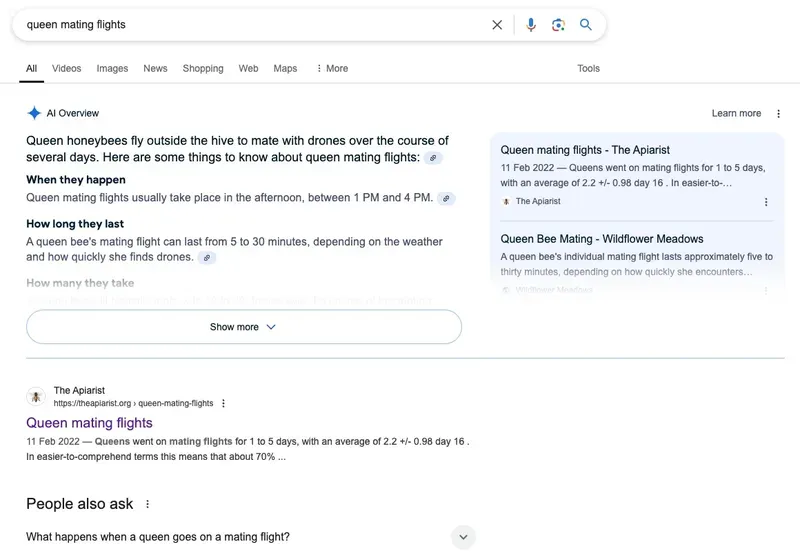
So, individual posts are read as emails by most subscribers {{3}}, visited online by subscribers who want to read the terrible jokes asides in the footnotes, and read by visitors that arrived here from Google, via social media {{4}} or from another page on this site.
All of which makes accurately determining the most popular posts tricky.

The graphs above are the overall visitor (hopefully reader!) traces for this year and last {{5}} excluding those that just read the emailed newsletter. The black arrow indicates the switch from WordPress to Ghost. The trace to the right of the arrow on the lower graph is smoother because the weekly Friday afternoon spike in reader numbers has gone (as they - hopefully - are all busy reading the emailed newsletter {{6}}).
The shape of the trace rather neatly matches the beekeeping year, higher in Spring and Summer.
Guesstimates
Although accurate counts are impossible more trouble than they're worth, I still have a reasonably good idea of which are the most read posts in 2024 ... because the majority were published in previous years. Older posts get visited a lot because they rank well in search engine results (not least because they are linked to from other sites on the web).
The 'Top 10' posts below all received three to five times the number of visits as the total newsletters sent each week. Even if everyone who received the newsletter opened it, that post still would not register this year, and probably won't for a season or two.
Finally, just to put these vague numbers into context.
The Apiarist has subscribers (who are signed up to receive the free newsletters) and sponsors (who pay to support the site and my writing; since May, ~33% of posts have been for sponsors only).
About 70% of subscribers read the weekly posts, whereas 85-90% of sponsors read the sponsor-only articles.
These figures are remarkably consistent, and the difference doesn't surprise me.
Sponsors are presumably more interested or engaged in their bees and beekeeping. This is further evidenced by the 25-40% of sponsors that 'click through' to one or more of the links within a post, at least three times the number followed by subscribers.
Alternatively, there's always the possibility that the posts written for sponsors are more interesting ... 😄.
Of course, it's not the same 70% or 90% each week that open the newsletter, but subscribers {{7}} who repeatedly never open the email are periodically removed from the mailing list to save me paying for emails which are never read. I send over 10,000 emails a month, and the costs of bulk emailing always seems to be increasing.
Anyway, enough navel-gazing ... here are the rankings.
Honourable mentions
Any half-decent awards ceremony deals with the recipients in reverse order, and this post - even if falling far short of 'half-decent' - is no different.
10 The size of a hive (2024): Some numbers to illustrate that bees "Live fast, die young", and why statements that 'workers live for six weeks' and 'the queen lays an average of 2000 eggs a day' are demonstrably wrong. Lots of assumptions, but an interesting insight into the lifespan of workers and the size of a colony.
9 Brood in all stages (2022): How to determine whether the queen's laying rate is increasing or decreasing. Again, some assumptions, some impenetrable graphs and some weird ratios, but nevertheless a useful insight into the dynamics of the colony.
8 Queen introduction (2021): I can only presume that the popularity of this post this year was because mated queens were especially valuable as mating was so poor ... whatever, I describe the way I do it and what science tells us about what works best. It may not be what you'd expect.
7 Beekeeping economics (2019): This was written so long ago I costed things in groats. Although the broad principles are correct - beekeeping is (or can be) a hobby that pays for itself - the numbers are now probably wildly wrong (if they were ever right to start with). With the introduction of decimalisation this post desperately needs a revamp.
6 Bigger queens better queens - part 1 (2024): The first (though, like Star Wars, there was a later prequel) of a series of posts about why bigger queens are better, and how beekeepers can take advantage of the mechanisms the colony uses to produce bigger queens. To be continued next year ...
5 Queen cells ... don't panic! (2018): This was the top post for the last four years (2019 to 2023). However, it's been a rubbish year weather-wise, so I suspect most beekeepers had fewer swarming problems this season.
4 Doing the splits (2024): What happens when you split a colony in two, leaving one half queenless? Queen-loss swarming and high levels of brood loss are what happens ... and how these things can be avoided. 'Walk away splits' are easy, but that doesn't make them good.
Bronze, silver and gold
3 The ultimate hive stand? (2022): This title was a bit 'tongue in cheek' ... the clue is the question mark. It's a perfectly good hive stand; better than many, worse than some. It's strong, stable and adjustable. However, it's not the 'ultimate' hive stand ... a pile of old tyres works just as well in many circumstances. What it is, is a well-crafted "clickbait" post title. Next Spring I'll have posts on 'What your choice of hive tool says about your personality' and 'Why beefarmers don't want you to know this easy way to make money from your bees'.
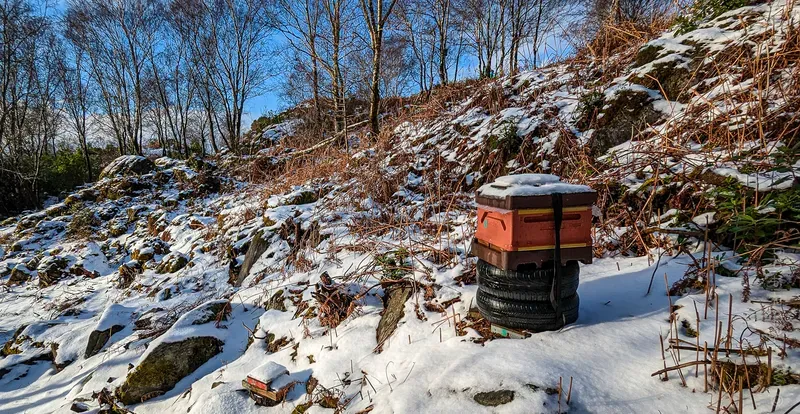
2 Mad honey (2018): this was also placed 2nd last year. As I wrote then, "surreal, totally surreal. An article about hallucinogenic honey ... largely irrelevant to UK beekeepers; if I can’t make it with the acres of rhododendron I’ve got on the West Coast, then no-one can". I'll briefly return to this topic in a couple of paragraphs as I think there's a missed marketing opportunity.
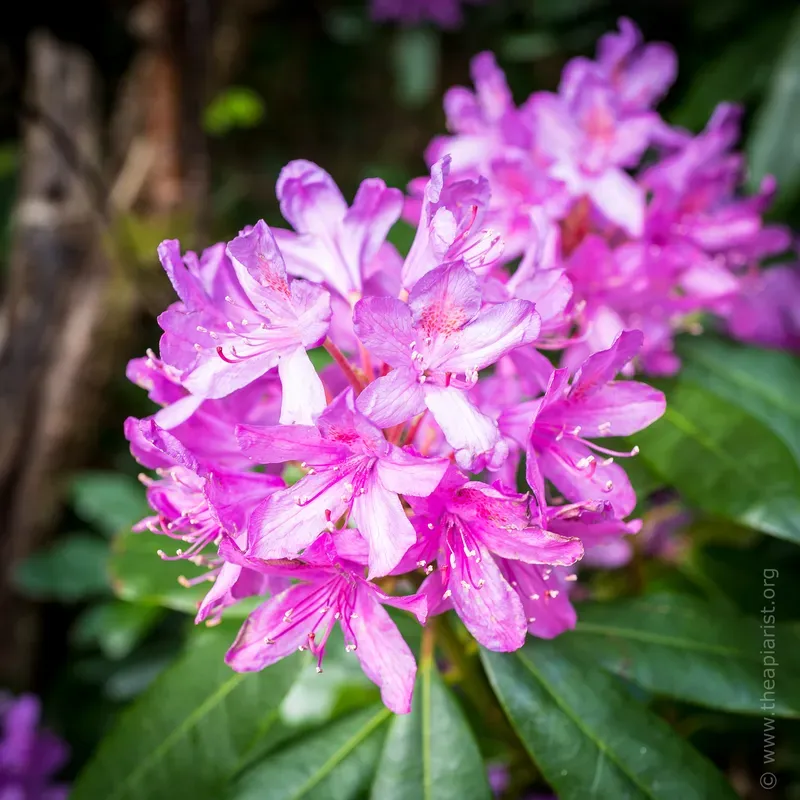
1 Demaree swarm control (2019): There's more than one way to do it. This post is perennially popular, though it's a method I'm told beekeepers have variable success with. The fact that it's not a method I particularly like (too many trapped drones and not ideal for more northerly latitudes) won't stop me revising this post sometime in the year ahead.
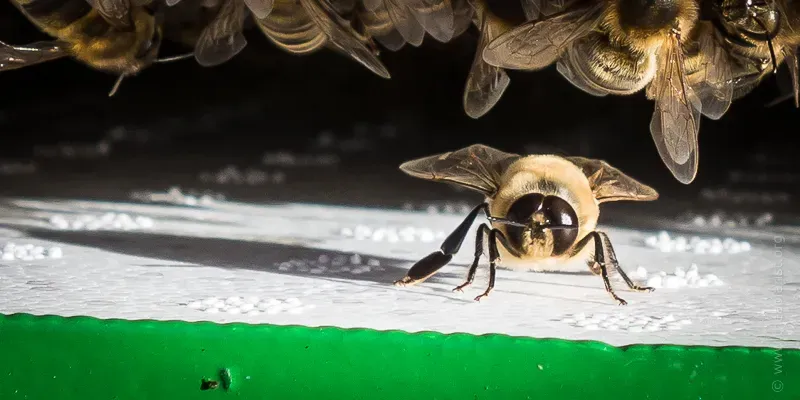
What does this tell us about beekeeping?
I'm not sure if this list provides any profound insights into the current state of beekeeping. About 50% of readers are from the UK, with ~90% of the remainder from the English-speaking Northern Hemisphere, so there will be some geographic/seasonal influence on what's popular.
My discussions with UK beekeeping associations - usually while doing the 'sound check' prior to an online talk - suggest that 2024 was subdued in terms of swarming and moderate to poor for queen rearing, and this does seem to be reflected in the pages visited.
To be certain, I'd need a larger dataset, a better understanding of correlation statistics and have the motivation to find out.
Nope ... I'm missing all three 😉.
My New Zealand and Australian readers are probably currently grappling with swarming and queen rearing - lucky blighters - but they only constitute ~4% of visitors, so barely 'nudge the dial'. Nevertheless, they are very welcome and a reminder that bees and beekeeping are much the same the world over.
Mad honey
The continuing popularity of Mad honey baffles me. It surged in the rankings in mid-2022 when a Turkish bear cub, stoned on deli bal (mad honey) featured in the news, but has remained surprisingly popular ever since.
This seems like a marketing opportunity.
There are several 'reserved terms' that may be used when labelling honey (e.g. blossom, comb).
Mad is not a reserved term. However, you can also prefix the word honey (which must be present) with terms such as heather or hedgerow or oil seed rape, as long as they are not misleading.
It's not clear how 'mad' would fit here, and I suspect that Trading Standards might not allow it on the grounds that it was misleading, or at least ambiguous (if they ever check this sort of thing).
Is the honey angry? Does it make you mad? Are you mad to sell it at that price ... or pay that much for a jar?
But, you can also use a geographic term, such as Scottish, or the name of your town or village.
Again, this must not be misleading, but often is.
There are tons of 'name-that-sounds-like-a-quaint-local-village' honey sold in leading supermarkets that are actually the product of "EU and non-EU countries", which usually means China.
These jars also carry the word 'honey' which is often also misleading. What it should say is 'rice syrup'.
Anyway, rant over as it's not very "season of goodwill" and all that ... where was I?
I've tried, but I can't find anywhere named Mad.
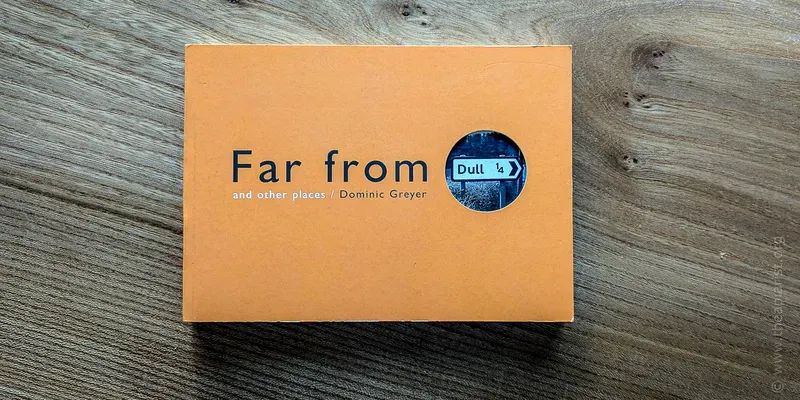
I checked my book of ridiculous place names in the UK, and searched online. I can thoroughly recommend this list from the USA for a chuckle.
There must be somewhere called Mad (or Madd perhaps), but it currently eludes me.
However, this search did make me wonder whether there are beekeepers selling geographically-named honey from Old (Northamptonshire), Ripe (East Sussex), Nasty (Hertfordshire), Hopeulikit (Georgia) or Happy (Texas {{8}}) ... or even, something more seasonal, Santa Claus (Arizona).
If you do keep bees in somewhere called Mad, I'd be happy to consider a sponsorship deal to give you access to the many thousands of visitors a year I get searching for 'mad honey'.
Thumbs up or thumbs down
Although the emailed newsletter makes separating readers from recipients a bit more difficult, it does carry an 'audience participation' section at the end.
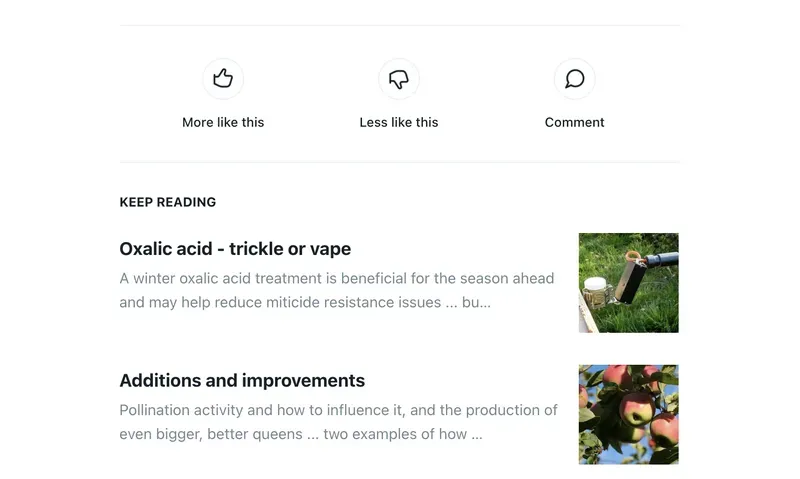
Those who read that far have the option to give the post a - Caligula-like - thumbs up ('more like this') or down ('less like this'), or to leave a comment. The icons link to the website, and the responses are tabulated.
Unfortunately, because pop-up footnotes aren't supported in the newsletter, this section follows the list of footnotes. Consequently, most readers miss it. Ho hum.

Fortunately, those that don't miss the audience participation section are usually positive (>95%). Either they like what they've been reading, only interested readers 'stay the course', or perhaps only polite readers provide feedback.
Without further evidence etc.
But, in some way, the negative feedback is more interesting.
Worse than bad reviews is to be ignored (Neil Diamond)
Some were to the recent post on climate change. Whilst I'm obviously disappointed that some readers didn't enjoy the post, not 'liking' it won't make the reality of climate change go away.
Other than a brief mention of the correlation between a warming world and industrialisation, that post was about climate change irrespective of its cause. Many beekeepers are acutely aware of the interaction between their bees and the environment. This will get more problematic. Extreme weather will be inconvenient - flooded apiaries, droughts - but the asynchrony between plants and their pollinators, with consequent habitat change, will probably be worse.
Gradual, but worse ... if not for us, then for future generations of beekeepers.
And bees.
Other readers do not like discussion of honey bees competing with native pollinators. I'm afraid you'll need to "get used to it". Scientifically this is a hot topic and the evidence is increasingly showing that, in certain circumstances, the presence of honey bees in an environment is detrimental.
Beekeepers need to engage with these discussions. If we don't, we cannot influence them. We have a responsibility to act as guardians of the environment, or there will be nowhere left for 'our' bees to forage and flourish.
Finally, there are one or two readers who consistently vote "less like this" on any posts containing graphs, or science, or posts that are on any bees other than honey bees, or posts that are on anything other than practical beekeeping.
Sorry ... as an ex-scientist with broad interests in bees, including honey bees, and the environment, I struggle to restrict myself to swarm control and mite treatment.
You can please some of the people all of the time, you can please all of the people some of the time, but you can’t please all of the people all of the time
John Lydgate (c. 1370-1451) was right 😄.
Conclusions
It's been an interesting year. The beekeeping, other than the summer honey harvest, was no better than average and - in places - much worse. Moving house just complicated everything.
Digitally, the move from WordPress in March worked well (for me at least). This move achieved what I needed it to; less system maintenance, more time for writing.
The introduction of sponsorship worked much better than expected, but not quite as well as I'd hoped. It will continue, not least because of the rise and rise of AI. Google (and many others) train their LLM systems - usually for free - on publications like this, and books, and (for a fee) scientific papers.
The original author receives no credit. There is a massive carbon footprint associated with the hardware and training. It's probably even worse for graphic artists. The main beneficiaries will be copyright lawyers 😦.
Where is the incentive to write or draw something novel and insightful, or amusing, or creative? Google (or whoever) reaps the advertising revenue while presenting - uncredited - the work of others, succinctly packaged in a manner that misses any nuanced arguments (but is probably better punctuated), and is sometimes completely wrong.
I'm beginning to sound like The Grinch again.
Back to beekeeping ... if your hives are heavy, your mites slaughtered and your frames built you can take the next week or two off and relax.
Happy Christmas
Sponsor The Apiarist
If this post helped or inspired your beekeeping, or provided a distraction from the drudgery of frame building or from after-dinner arguments with visiting family members, then please consider sponsoring The Apiarist. Sponsorship supports the publication of these posts, and the many hours spent writing them.
Coffee is also always welcome 😄.
Thank you
Notes
In the interests of space I've had to leave out some of the stuff I'd planned to include about next year ... I blame the hours I spent researching rude place names to pair with honey.
Posts for sponsors will continue to be about one-third of those published, but I'm also going to write some posts specifically for new beekeepers. There's also some of my short, semi-random thoughts (BeeMusings) on bees and beekeeping which I want to introduce.
More posts on the website will be restricted to signed-in subscribers and sponsors with the intention of avoiding the AI page scalpers. If you have problems accessing a post, check whether the coloured button in the top right hand corner of the page is labelled 'Account' or 'Subscribe'. If the latter, click the button, scroll to the bottom of the page and 'Sign in'.
If you want to practice, try this post on 'Enough bees' from early April which is now restricted access.
{{1}}: Even including the numerous variants - some simply different, some of questionable validity and some just plain wrong - I've seen described.
{{2}}: This is the small kinked part of the antenna immediately after the scape, and before the flagellum, where the antenna is hinged ... and, if you didn't know that, then you should sign up for my series on 'The left antenna of the worker honey bee (parts I to IV)' that I'll be posting in March and April 2025.
{{3}}: Remembering that, formally, I've no idea whether anything is read, I just know whether the email is opened or the page accessed.
{{4}}: It's worth noting that only a tiny number of visits (well under 1%) have ever originated directly from social media, mainly via Facebook. I no longer use Twitter/X.
{{5}}: Generated using a small piece of code that I've always had buried in the page.
{{6}}: Many are ... ~30% of newsletter emails are opened within 3 hours.
{{7}}: Not sponsors ... if you sponsor The Apiarist and never open another email I'll always leave you on the email list until you terminate your sponsorship. I'll be disappointed, but still grateful.
{{8}}: Texas ... where do I start? I could have listed dozens of places from Texas! For the broad-minded there are also lots of NSFW place-names which, suffixed with 'honey', will provide hours of entertainment.
Join the discussion ...